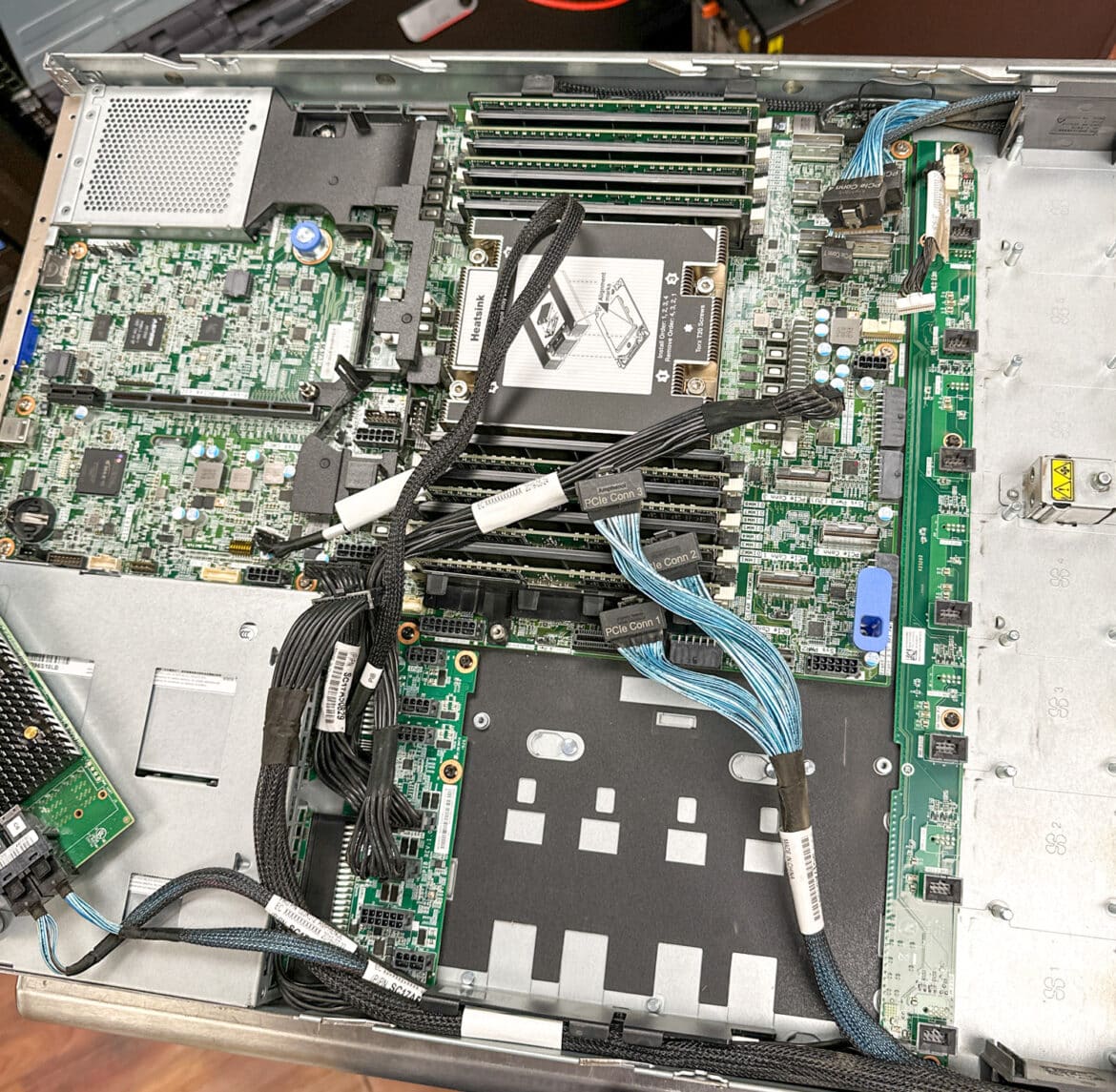Three years ago, the Lenovo ThinkSystem SR635 was introduced into our StorageReview testing lab as a high-performing, feature-rich server equipped to handle a wide variety of tasks. With a robust build and packed specifications, the SR635 had an immediate impact, quickly becoming one of the cornerstones of our testing environment. We recently decided to revisit this reliable machine many years on to look at how it has held up as a mainstay of our lab over that time.
Three years ago, the Lenovo ThinkSystem SR635 was introduced into our StorageReview testing lab as a high-performing, feature-rich server equipped to handle a wide variety of tasks. With a robust build and packed specifications, the SR635 had an immediate impact, quickly becoming one of the cornerstones of our testing environment. We recently decided to revisit this reliable machine many years on to look at how it has held up as a mainstay of our lab over that time.
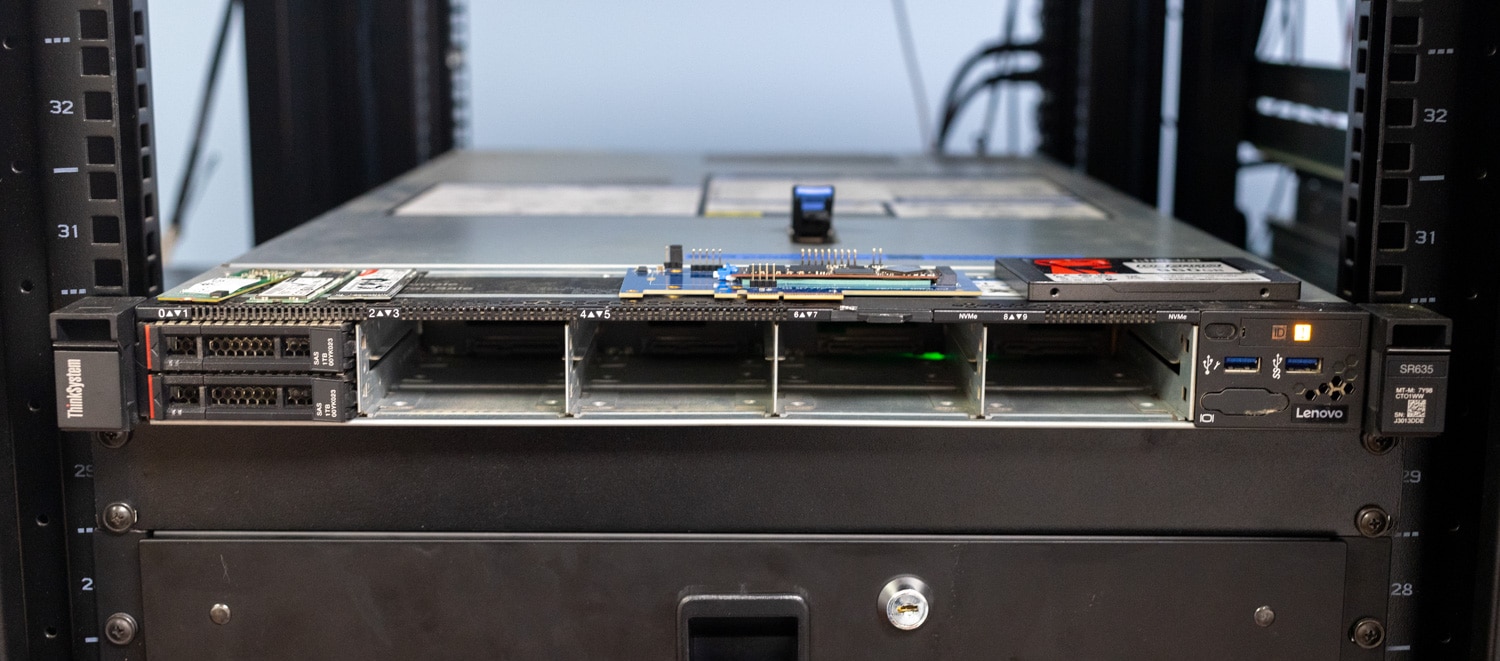
Our objective for this mini-review is to provide an analysis of the Lenovo SR635’s long-term capabilities and to determine how well it has aged in the context of an ever-evolving storage landscape. As businesses look for long-term tech investments, understanding how well a server fares over extended periods is crucial. Part of that is repairing or swapping components. This revisit aims to answer precisely that.
Initial Impressions of the Lenovo ThinkSystem SR635
When the Lenovo ThinkSystem SR635 was first unboxed and tested in our lab back in 2020, it was quite clear that this was not just another server that we benchmarked; it came loaded with features that made it stand out. For businesses and enterprises, the SR635 offered a glimpse into the future, promising a long-lasting, robust experience.
Simply put, it was met with immediate approval. The server came with specifications that were industry-leading at the time. It was one of the few servers in our lab to offer the full benefits of AMD’s second-generation EPYC processors, supported up to 2TB of 3200MHz DRAM, and end-to-end PCIe Gen4 support. This feature set was impressive, and from our initial testing, the performance metrics were equally exceptional.
It sports a sleek design and durable build quality, while installation and setup were smooth thanks to Lenovo’s meticulously crafted guides and intuitive interface. The cooling system was efficiently designed, ensuring that thermal throttling was a non-issue even under heavy workloads. Features like hot-swappable components simplified maintenance, eliminating the need to power down the system for component replacements.
Three years ago, our expectations from the SR635 were high, and the server certainly lived up to them. It’s important to note that while the initial setup was hassle-free and quick, what impressed us most was the server’s potential for serviceability and upgradeability. These were features that hinted at the server’s longevity, and over the years, it has certainly proven itself in this regard.
Relevance of the Lenovo ThinkSystem SR635 Today
The server landscape has certainly evolved since the release of the Lenovo SR635, with newer models boasting increasingly impressive specs. However, when the SR635 is compared to more recent servers of the same class, it still holds its own remarkably well, despite being a little dustier than when it came in.
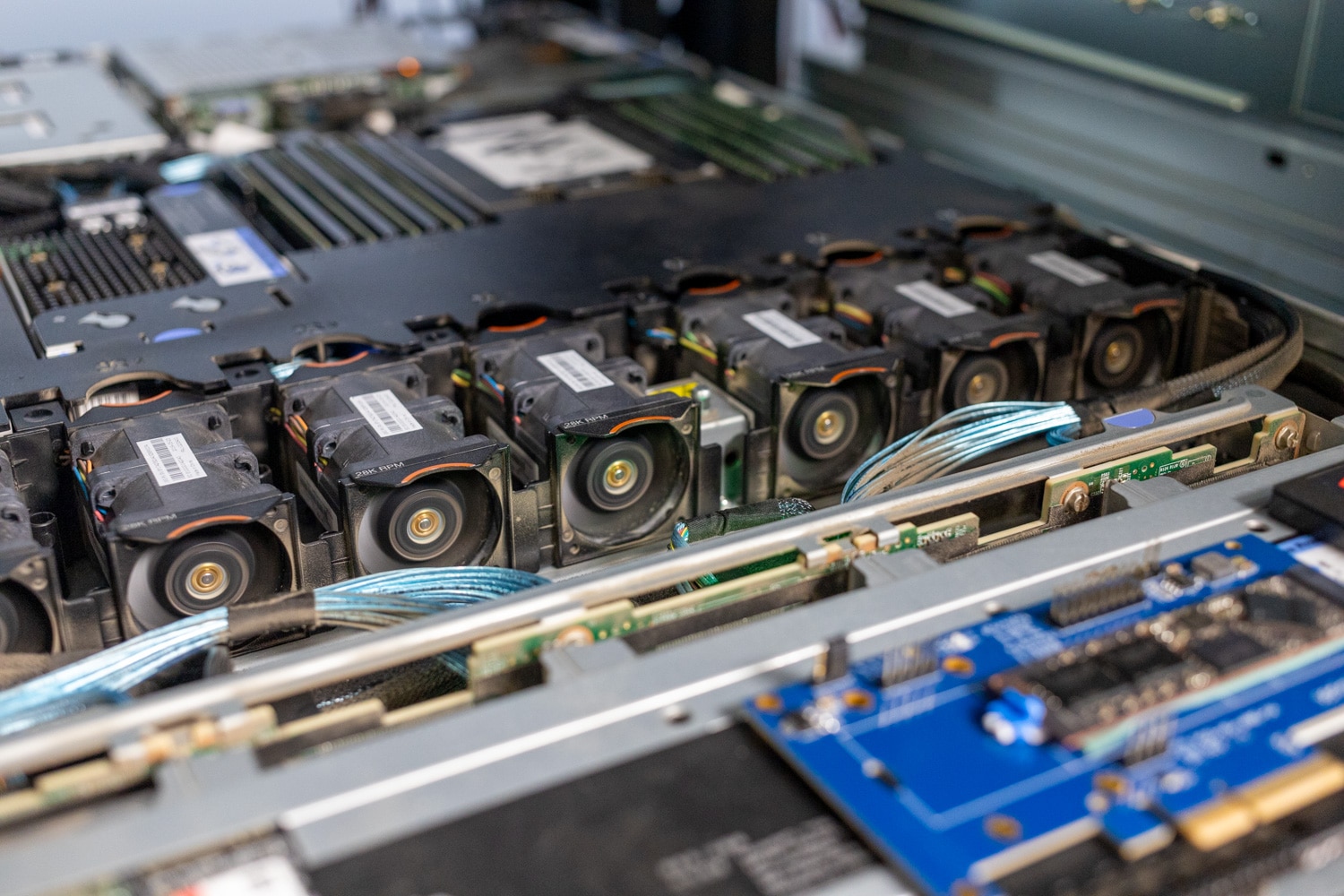
One of the most impressive aspects of the SR635 is how well it has adapted to the changing landscape. As the industry moves towards faster, more efficient hardware, it’s very easy for older models to become obsolete. Businesses are also more focused than ever on the long-term implications of their hardware purchases. One of the more critical aspects companies consider when investing in technology is its future-proofing capabilities.
Thanks to its scalable architecture and ongoing software updates, the SR635 remains a viable choice for modern workloads. The SR635 has not only aged well but has also adapted to changing technological requirements. Periodic firmware updates and the inherent upgradeability of the server have made it a prime example of how to future-proof a hardware investment, allowing for extended utility while minimizing long-term costs. To this end, the server has shown not just stable but enhanced performance in some areas, thanks to these optimizations Lenovo has provided over the years. Whether it was computational tasks or storage-related workloads, the SR635 performed impressively.
Performance and Reliability of the Lenovo ThinkSystem SR635
During the years since its arrival, the SR635 has proved itself a resilient workhorse in our lab. We’ve paired it with a plethora of devices and used it in a multitude of settings, from multi-node clusters to high-capacity storage arrays. For example, we recently used it to benchmark the Solidigm P5336 (a whopping 61.44TB capacity SSD), where it found impressive success using the Lenovo hardware. The drive even earned a “Best of 2023” nod.
Needless to say, performance metrics have consistently stayed high, ensuring that the SR635 remains one of our go-to servers for varied testing scenarios. Our initial SR635 review sample was part of the pre-production mix, which leveraged a different line of BIOS updates parallel to the production servers. About nine months ago, we decided to swap the motherboard to make this platform identical to the production-grade ThinkSystem SR635s going forward.
With the motherboard being the most core component of the platform the repair and replacement process took some planning. Our test system came equipped with 10 NVMe bays in front and two in the rear, requiring a ton of careful PCIe cabling throughput. Many of these cables don’t just need to fit, they need to be placed in an exact position to not impede airflow.
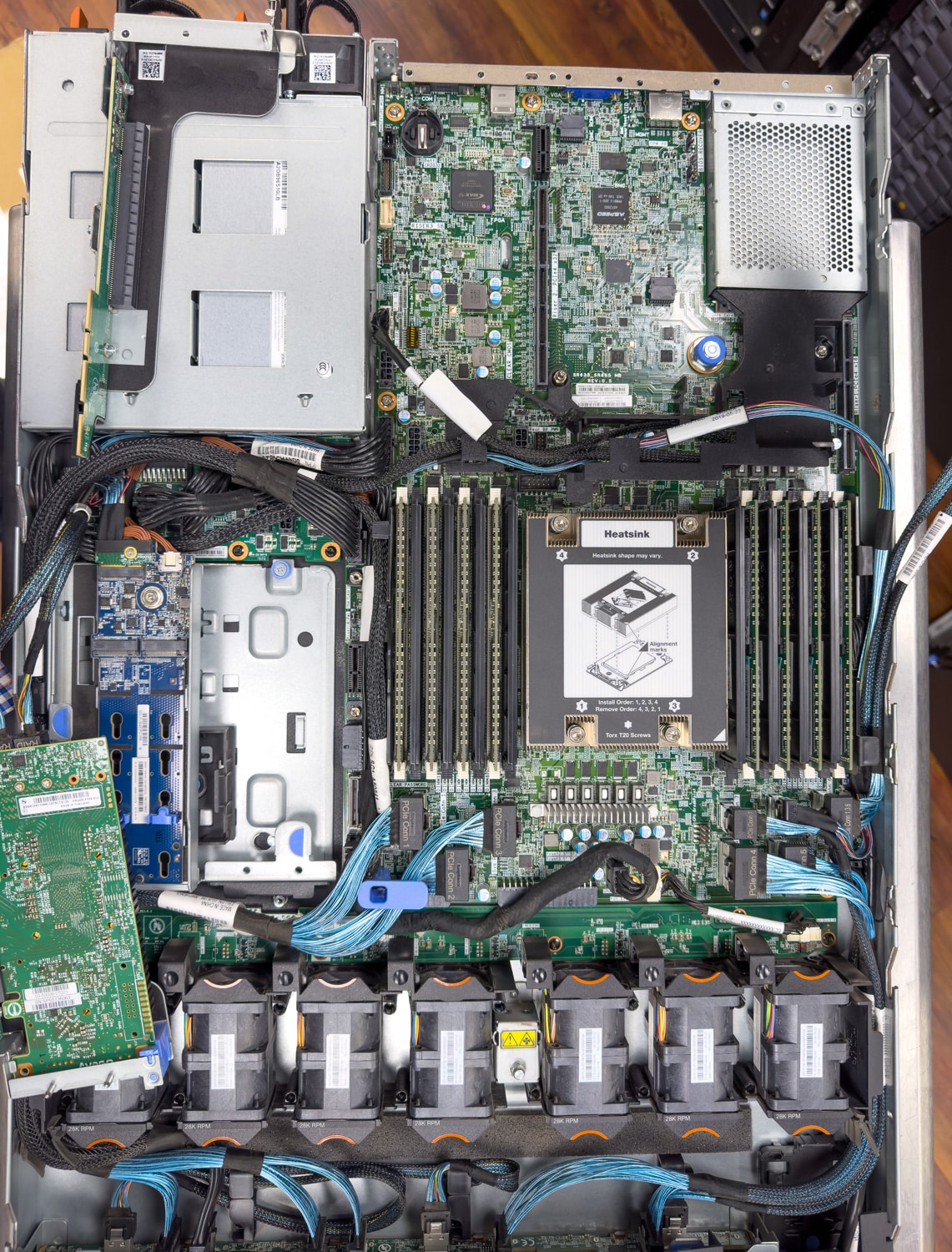
The best way to approach this type of repair job, as well as others that involve a lot of wiring is to take photos along the way. Start with an overall picture to help with reference points. For any bundle of wiring or connections, get photos showing the cable itself for identification as well as how it is situated inside the platform. Here we exposed most of the system before disconnecting devices and then zoomed into areas with numerous connections.
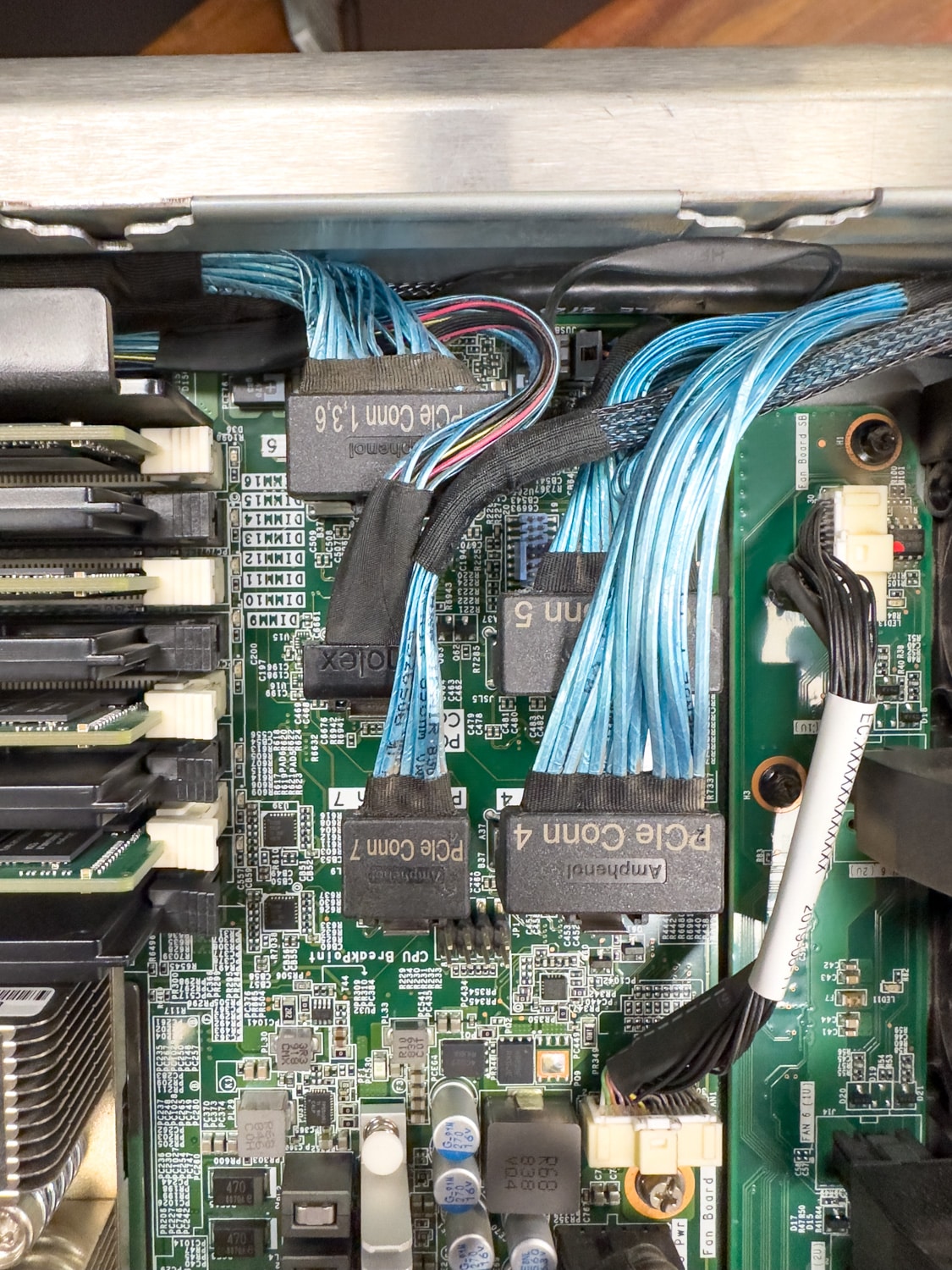
The PCIe cables for all of the NVMe bays were the main priority. While numbered, the cables are the thickest in the chassis and go through passages in a specific order so as they branch off to their final positions they take up the least amount of space.
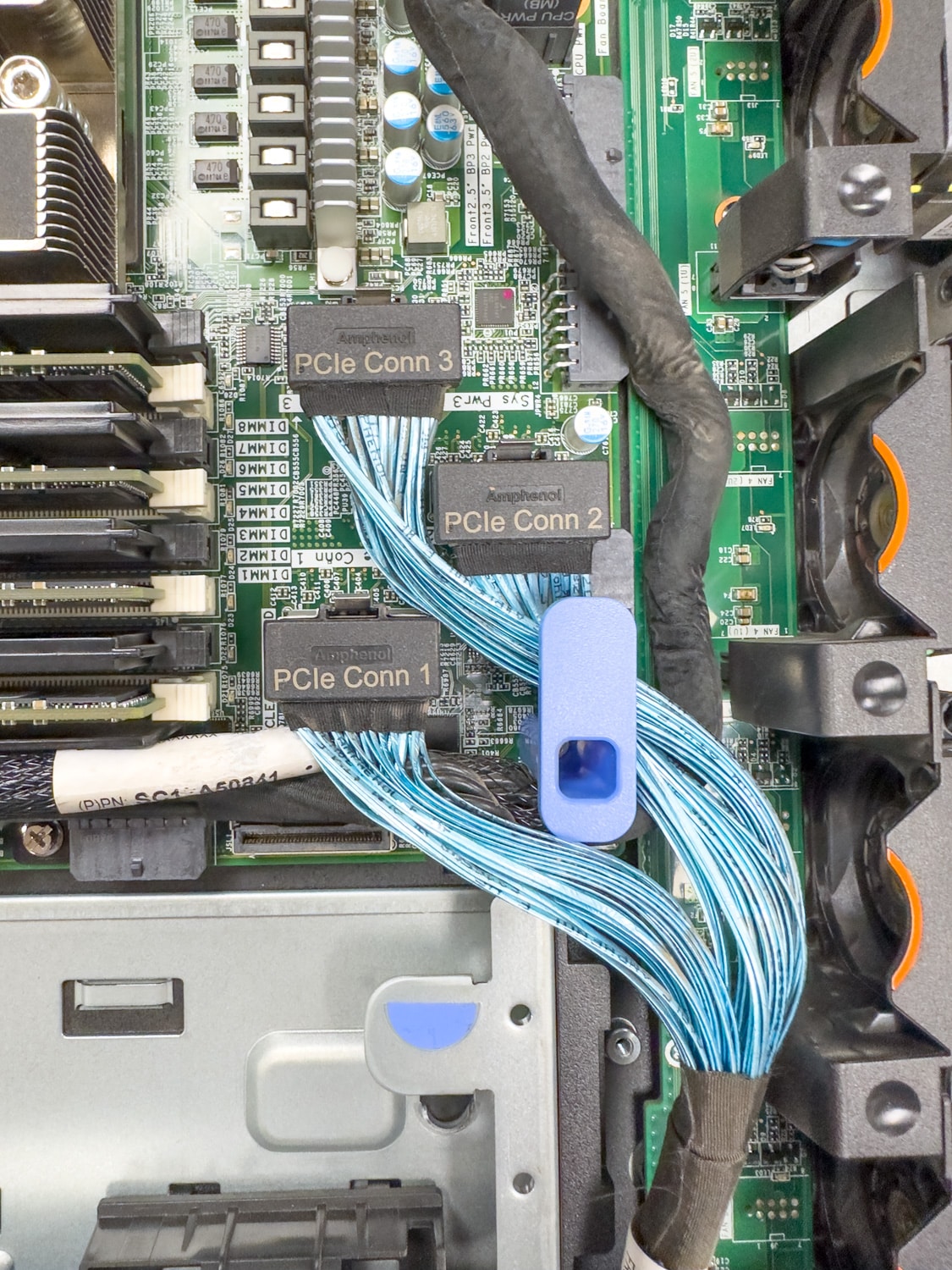
For these three PCIe cables, you can see how they are almost woven into position around the blue standoff. If you don’t put them back in as expected the airflow cowl can’t seat flush and the top cover of the chassis won’t press down correctly. You also run the risk of binding a cable into the edge of some bracket which can damage it.
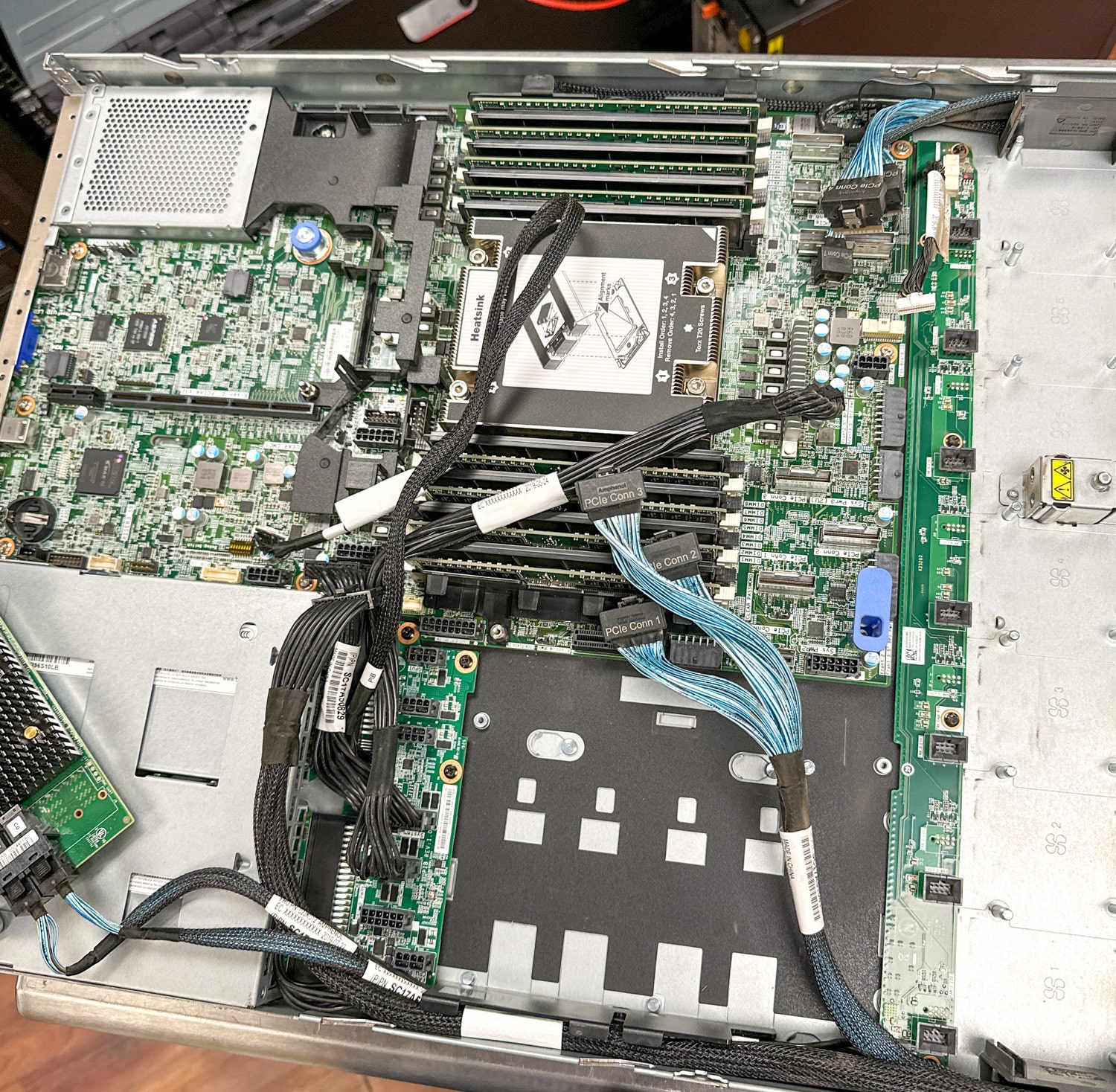
In this regard, the SR635 is a great example of a server that can adapt and grow alongside a business. With its robust initial specifications and ongoing support, the server continues to meet the increasingly demanding requirements of modern data center workloads, ensuring that it stays relevant in a fiercely competitive market.
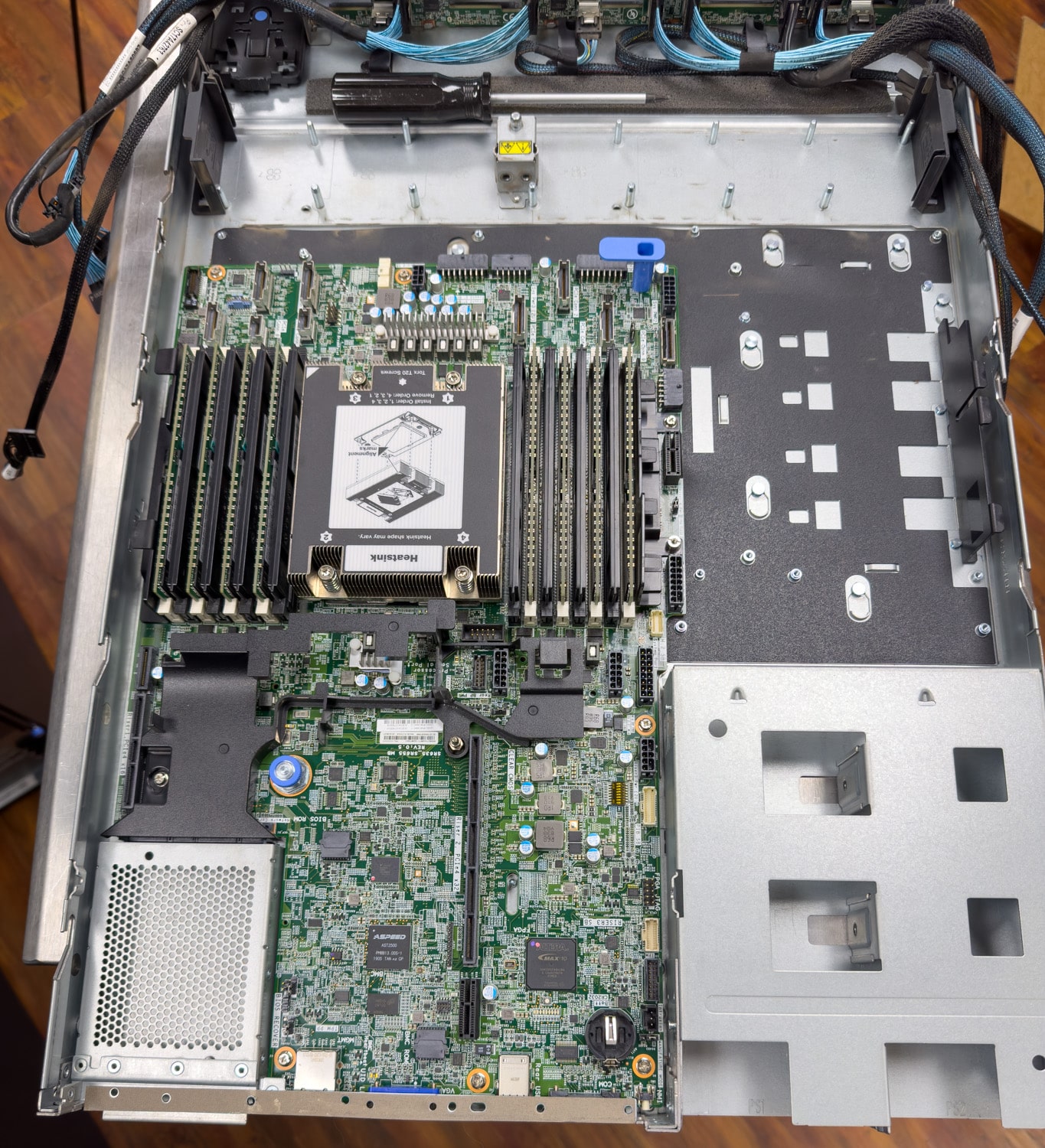
With all of the cables removed from the motherboard, the SR635 has just one screw holding it into place. Below the CPU is one blue latch that you lift up, and then the entire motherboard tray can slide forward and lift out. The replacement component Lenovo service provides includes the tray as well, so the replacement sides in the reverse of removal. After the new motherboard is in you refer to your cabling photos to get it all back together.
Conclusion
After three years of rigorous testing and usage, the Lenovo ThinkSystem SR635 has not only met but in many cases exceeded our expectations. It has demonstrated remarkable durability and adaptability, traits that are incredibly valuable in an industry marked by rapid changes and advancements. From a performance standpoint, it remains a strong contender, proving that good engineering and regular updates can extend the life of server hardware considerably.
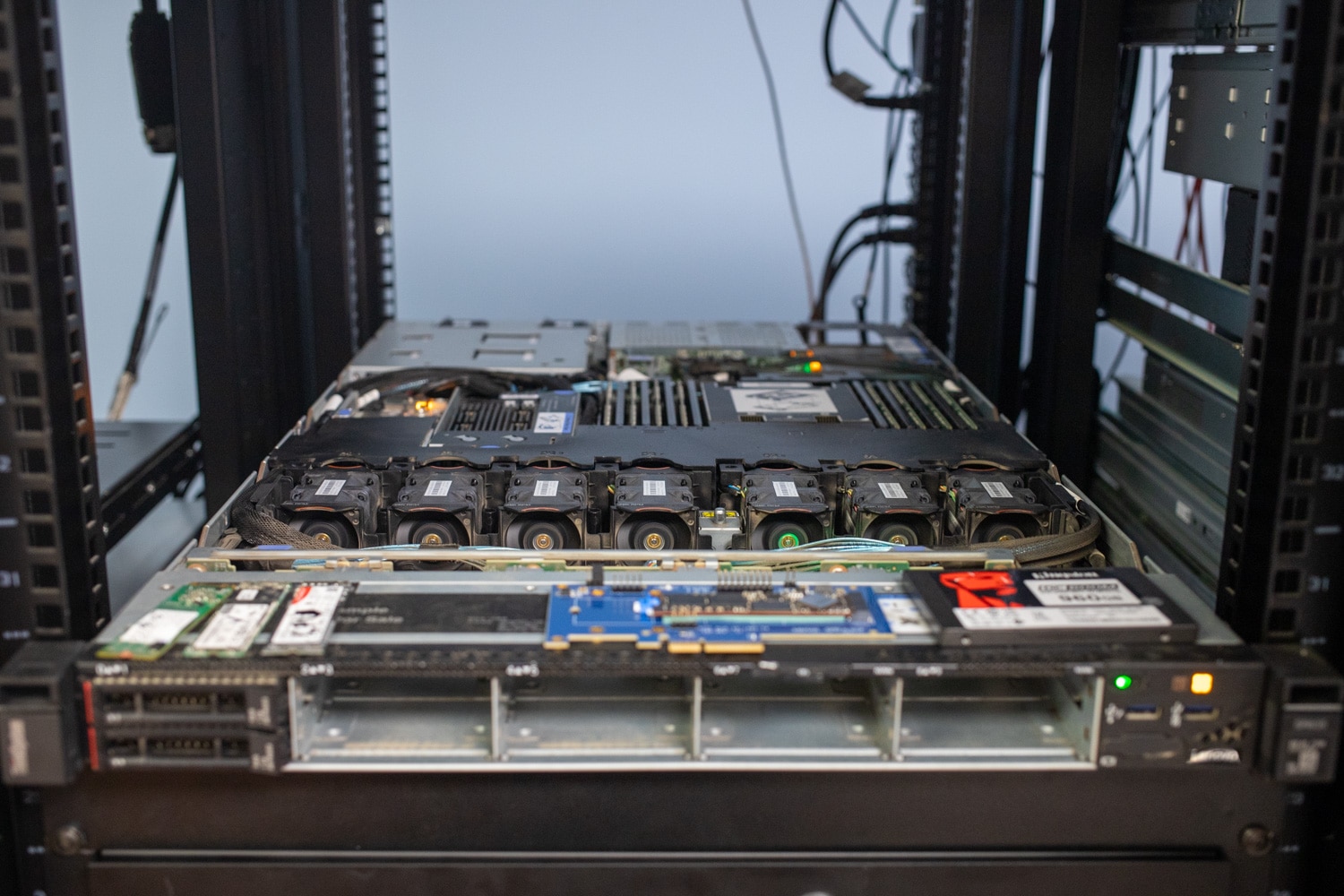
Looking ahead, the SR635 will continue to be a critical part of the StorageReview lab testing environment. Its scalability ensures that it will remain relevant to us for years to come, and its robust performance metrics make it a reliable choice for benchmarking a range of different products, applications, and workloads.
We’re often enamored by the next high-end server to show up, one with more cores, faster cores, a bigger DRAM footprint, and support for more PCIe slots or storage bays…it’s easy to overlook the older tech in our rack. But a the same time, we owe servers like the SR635 an affirmative head nod for a job perpetually well done, our old reliable Gen4 SSD testbed.
Engage with StorageReview
Newsletter | YouTube | Podcast iTunes/Spotify | Instagram | Twitter | TikTok | RSS Feed

